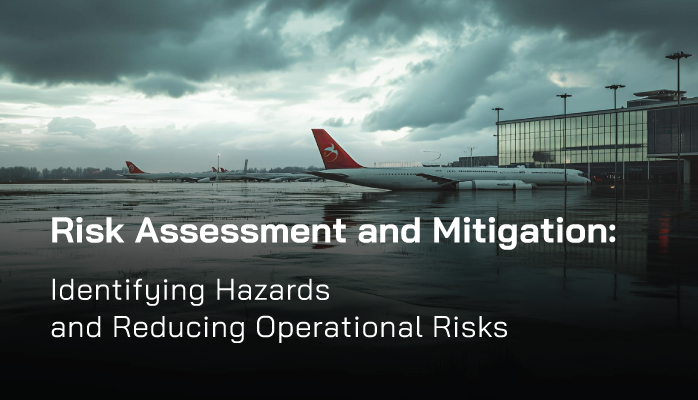Risk Assessment and Mitigation

Aviation safety managers are tasked with ensuring the skies remain safe for passengers, crew, and aircraft. A critical component of this responsibility is conducting effective risk assessments and implementing mitigation strategies to identify hazards and reduce operational risks to As Low as Reasonably Practical (ALARP).
This short article explores
- the importance of risk assessment in aviation safety management systems (SMS),
- outlines a structured approach to hazard identification, and
- provides actionable mitigation strategies to enhance safety and compliance.
The Importance of Risk Assessment in Aviation
Aviation is a high-stakes industry where even minor oversights can lead to catastrophic consequences. According to the International Civil Aviation Organization (ICAO), proactive risk management is essential for preventing accidents and ensuring operational resilience.
Risk assessment enables safety managers to anticipate hazards, prioritize resources, and implement control measures before incidents occur.
Key benefits of risk assessment include:
- Proactive Hazard Identification: Detect potential risks before they escalate.
- Regulatory Compliance: Align with standards like FAA Part 5 and EASA Safety Management Systems (SMS).
- Cost Savings: Prevent costly incidents through early intervention.
- Enhanced Safety Culture: Foster a proactive mindset among staff and stakeholders.
By integrating risk assessment into daily operations, aviation organizations can safeguard lives and assets while maintaining operational efficiency.
Related Proactive Risk Management Articles
- From Reactive to Proactive Hazard Identification in Aviation SMS
- What Is Proactive Hazard Identification and Risk Management in Aviation SMS
- Difference Between Proactive and Mitigative Risk Controls in Aviation SMS
Understanding Risk Assessment in Aviation
Risk assessment is a systematic process of identifying hazards, evaluating their likelihood and severity, and implementing control measures to mitigate them. In aviation, hazards can arise from various sources, including human factors, equipment failures, environmental conditions, and organizational processes.
Core Components of Risk Assessment
- Hazard Identification: Recognizing potential sources of harm.
- Risk Analysis: Assessing the likelihood and impact of each hazard, i.e., severity.
- Risk Evaluation: Prioritizing risks based on severity and probability.
- Mitigation Planning: Developing strategies to eliminate or reduce risks to ALARP.
- Monitoring and Review: Continuously evaluating the effectiveness of risk controls.
A structured risk assessment ensures that no hazard goes unnoticed and that mitigation efforts are targeted and effective.
Step-by-Step Guide to Risk Assessment for Aviation Safety Managers

Aviation safety managers can follow this comprehensive process to conduct risk assessments and mitigate operational risks effectively.
1. Assemble a Risk Assessment Team
Form a multidisciplinary team, including pilots, maintenance technicians, air traffic controllers, and safety officers. Diverse perspectives ensure comprehensive hazard identification and practical mitigation strategies.
2. Identify Hazards
Systematically identify hazards across all operational areas, such as:
- Flight Operations: Pilot fatigue, adverse weather, or navigation errors.
- Maintenance: Inadequate inspections, tool control or faulty equipment.
- Ground Operations: Runway incursions, vehicle collisions, or improper fueling.
- Organizational Factors: Poor communication, insufficient training, or outdated procedures.
Tools like checklists, brainstorming sessions, and historical incident data can aid in hazard identification. For example, reviewing near-miss reports may reveal recurring issues like miscommunication during taxiing.
3. Analyze and Evaluate Risks
Assess each hazard’s likelihood (e.g., rare, occasional, frequent) and severity (e.g., minor, major, catastrophic). Use a risk matrix to prioritize hazards. For instance:
- High Risk: Frequent runway incursions with catastrophic potential.
- Low Risk: Rare paperwork errors with minor consequences.
Quantitative tools, such as Failure Modes and Effects Analysis (FMEA), can provide data-driven insights for complex hazards.
4. Develop Mitigation Strategies
Design control measures to eliminate or reduce risks, following the hierarchy of controls:
- Elimination: Remove the hazard entirely (e.g., replace outdated equipment).
- Substitution: Use safer alternatives (e.g., non-toxic de-icing fluids).
- Engineering Controls: Implement physical safeguards (e.g., runway incursion warning systems).
- Administrative Controls: Update procedures or training (e.g., mandatory fatigue management programs).
- Personal Protective Equipment (PPE): Provide gear like high-visibility vests for ground crews.
For example, to mitigate pilot fatigue, safety managers could implement stricter duty-hour limits and provide fatigue risk management training.
Related Articles for Control Measures
- Difference Between Hazards, Risks, and Control Measures in Aviation SMS
- How to Implement Effective Control Measures
- How to Monitor the Effectiveness of Control Measures
5. Implement Mitigation Measures
Execute mitigation plans promptly, ensuring clear communication with all stakeholders. Assign responsibilities, set deadlines, and allocate resources to support implementation.
6. Monitor and Review
Continuously monitor the effectiveness of mitigation measures through safety audits, performance metrics, and feedback from staff. Adjust controls as needed to address emerging risks or changing conditions. For instance, if new technology reduces runway incursions, update training to incorporate its use.
7. Document and Report
Maintain detailed records of risk assessments, including identified hazards, risk levels, and mitigation plans. Share findings with leadership and regulatory bodies to ensure transparency and compliance with ICAO Annex 19 standards.
Examples of Risk Mitigation in Aviation
To illustrate, here are mitigation strategies for common aviation hazards:
Hazard: Pilot Fatigue
- Risk: High likelihood, major severity (impaired decision-making).
- Mitigation:
- Enforce FAA/EASA flight-duty-time regulations.
- Implement fatigue risk management systems (FRMS).
- Provide crew rest facilities and education on sleep hygiene.
Hazard: Runway Excursions
- Risk: Occasional likelihood, catastrophic severity.
- Mitigation:
- Install engineered materials arresting systems (EMAS) at runway ends.
- Enhance pilot training for crosswind landings.
- Improve runway surface maintenance to reduce hydroplaning.
Hazard: Maintenance Errors
- Risk: Rare likelihood, major severity (equipment failure).
- Mitigation:
- Use digital maintenance tracking systems to ensure compliance.
- Conduct regular technician certification programs.
- Implement double-check protocols for critical repairs.
Challenges in Risk Assessment and How to Overcome Them
Aviation safety managers may face obstacles during risk assessments, including:
-
Incomplete Data: Limited incident reports or unreliable metrics. Solution: Encourage anonymous reporting and leverage flight data monitoring (FDM) systems.
-
Resistance to Change: Staff reluctance to adopt new procedures. Solution: Engage employees through training and highlight safety benefits. Get top management support or use a "safety champion" to promote a positive safety culture.
-
Resource Constraints: Budget or staffing limitations. Solution: Prioritize high-risk hazards and explore cost-effective solutions like commercial off the shelf (COTS) database software tools.
-
Complex Operations: Interconnected systems complicating risk analysis. Solution: Use advanced tools like Bowtie Analysis to map risks and controls.
Related Articles for Performing Bowtie Analysis in Aviation SMS
- What, Why, and How to Use Bowtie Analysis in Aviation SMS
- How to Do Bowtie Analysis in Aviation SMS – 5 Step Walkthrough
- 3 Ways You’re Not Using the Bowtie in Aviation SMS
Leveraging Technology for Risk Assessment
Technology enhances the efficiency and accuracy of risk assessments:
- Flight Data Monitoring (FDM): Analyzes flight parameters to detect trends like unstable approaches.
- Predictive Analytics: Uses AI to forecast risks based on historical data.
- Safety Management Software: Tools like Aviation Safety Management Systems (ASMS) streamline hazard tracking and reporting.
- Drones and Sensors: Monitor airfield conditions to identify hazards like wildlife or debris.
By integrating these tools, safety managers can make data-driven decisions and stay ahead of risks.
Building a Proactive Safety Culture
Risk assessment is most effective within a proactive safety culture. Safety managers should:
- Promote open communication and anonymous hazard reporting.
- Conduct regular safety training and simulations.
- Recognize employees who contribute to risk identification and mitigation.
- Collaborate with industry peers to share best practices and lessons learned.
A strong safety culture ensures that risk management is a shared responsibility across the organization.
Conclusion
Risk assessment and mitigation are cornerstones of aviation safety. By systematically identifying hazards, evaluating risks, and implementing targeted controls, safety managers can prevent incidents and enhance operational resilience. Leveraging technology, fostering a proactive safety culture, and adhering to regulatory standards ensure that aviation organizations remain safe and compliant.
Start reviewing your risk assessment processes today to protect your operations and ensure safer skies.
Call to Action: Conduct a hazard identification audit this month. Are your mitigation strategies effective? Strengthen your safety framework to reduce risks and elevate aviation safety.
Are you lacking modern technology to reduce workloads and improve safety. SMS Pro can help. Contact us today to learn more.








